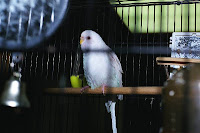Malcolm wrote with a question about his pair of Lutino Bourkes who don’t appear to be interested in each other and he wonders if there is a way to sex them without putting them through a vet exam.
 |
| This Lutino Bourke is not one of my birds. Wish it was. |
If you enter "Sexing Bourkes" in the search feature above, you will get those posts and others that reference sexing. There are also "Labels" at the end of each post. Click on a topic and it will bring up all related posts.
As you may know, adult normal Bourkes are easier to sex because the males have a tiny blue line of feathers over their cere (nostrils).
In Lutino's, like Rosa’s, look for the male to stand up straight, throw his shoulders back and flair his wings slightly. He may only do this when he's mature and interested in breeding because there's a hen present, although I've had youngsters in mixed cages tell me what sex they are this way (and it always proved true). When mature hens flair their wings, it's typically downward as they lean forward, as if to sweep the ground. They also put their tails up and cheep to attract a male.
The odd thing about that female behavior is that I've seen males do that when their own mate is no longer willing to breed. Are they showing her what they want her to do, maybe? Or, is it because of a hormone change in older birds? That's something I've been considering writing about.
Here's a link to one of my posts on sexing. Click here > More on Sexing Bourkes
Best of luck.
Peace & Blessings.














